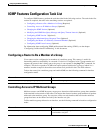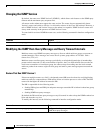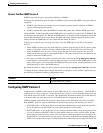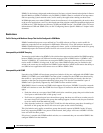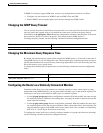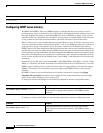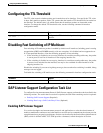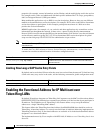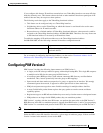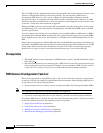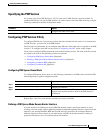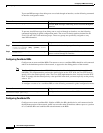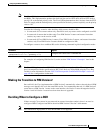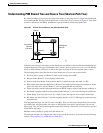
Configuring IP Multicast Routing
Configuring PIM Version 2
IPC-417
Cisco IOS IP Configuration Guide
If you configure this feature, IP multicast transmissions over Token Ring interfaces are more efficient
than they formerly were. This feature reduces the load on other machines that do not participate in IP
multicast because they do not process these packets.
The following restrictions apply to the Token Ring functional address:
• This feature can be configured only on a Token Ring interface.
• Neighboring devices on the Token Ring on which this feature is used should also use the same
functional address for IP multicast traffic.
• Because there are a limited number of Token Ring functional addresses, other protocols could be
assigned to the Token Ring functional address 0xc000.0004.0000. Therefore, not every frame sent
to the functional address is necessarily an IP multicast frame.
To enable the mapping of IP multicast addresses to the Token Ring functional address
0xc000.0004.0000, use the following command in interface configuration mode:
For an example of configuring the functional address, see the section “Functional Address for IP
Multicast over Token Ring LAN Example” later in this chapter.
Configuring PIM Version 2
PIM Version 2 includes the following improvements over PIM Version 1:
• A single, active RP exists per multicast group, with multiple backup RPs. This single RP compares
to multiple active RPs for the same group in PIM Version 1.
• A bootstrap router (BSR) provides a fault-tolerant, automated RP discovery and distribution
mechanism. Thus, routers dynamically learn the group-to-RP mappings.
• Sparse mode and dense mode are properties of a group, as opposed to an interface. We strongly
recommend sparse-dense mode, as opposed to either sparse mode or dense mode only.
• PIM join and prune messages have more flexible encodings for multiple address families.
• A more flexible hello packet format replaces the query packet to encode current and future
capability options.
• Register messages to an RP indicate whether they were sent by a border router or a designated router.
• PIM packets are no longer inside IGMP packets; they are standalone packets.
PIM Version 1, together with the Auto-RP feature, can perform the same tasks as the PIM Version 2
BSR. However, Auto-RP is a standalone protocol, separate from PIM Version 1, and is Cisco proprietary.
PIM Version 2 is a standards track protocol in the IETF. We recommend that you use PIM Version 2.
Note The simultaneous deployment of Auto-RP and BSR is not supported.
Either the BSR or Auto-RP should be chosen for a given range of multicast groups. If there are PIM
Version 1 routers in the network, do not use the BSR.
Command Purpose
Router(config-if)# ip multicast use-functional
Enables the mapping of IP multicast addresses to the Token Ring
functional address.



